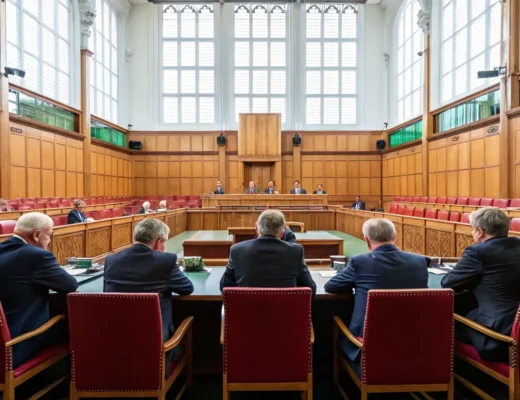U.S. stock markets rallied on Friday as the White House expressed “great optimism” in the economy.
The Dow Jones Industrial Average climbed 600 points, while the S&P 500 and Nasdaq Composite rose by 1.8% and 2%, respectively. Throughout the week, these indexes saw substantial gains, primarily driven by a pause in several tariffs announced by President Donald Trump.
The Dow rose 6% or over 2,300 points, the S&P 500 jumped 8.2%, and the tech-heavy Nasdaq soared 11.6%. The market upswing was fueled by Trump’s decision to delay the implementation of several harsh tariffs. This decision provided a reprieve from the ongoing trade tensions with China, which responded by announcing a 125% tariff on American imports following the US’s 145% tariff on Chinese goods.
Indian Stock Market: Inflation, US jobless claims data and China Q1 GDP to drive markets in truncated week https://t.co/ZaW1d7e2DT
— ET NOW (@ETNOWlive) April 14, 2025
Despite the rally, questions remain about the sustainability of these upswings, given the volatile market reactions to uncertain economic policies. Various economic indicators also painted a mixed picture, with the US dollar index falling to a three-year low and US treasury yields increasing, signaling potential future inflation. Some small businesses have started adding a “tariff surcharge” to their products to highlight the impact of tariffs on consumer prices.
Ryan Babenzian’s Jolie Skin Co, which sells shower heads that filter water, is among those implementing this practice.
Per this Bloomberg chart, the US bond yield rollercoaster continued today with an 11 basis drop in the 10-year. This was accompanied by 0.6-1.1% gains in the major US stock market indices.
The appreciated return of relative market calm hides a division of views on yields —… pic.twitter.com/3myX8aAeJs— Mohamed A. El-Erian (@elerianm) April 14, 2025
Dow climbs on tariff delay
Importers have reported issues with the US Customs and Border Protection (CBP) system, which has struggled to discern between goods shipped before and after the tariffs were imposed.
The CBP is working to resolve these issues, and the Federal Reserve is closely monitoring the economic volatility. Boston Federal Reserve CEO Susan Collins stated that the Fed is prepared to deploy various tools to stabilize the economy but hinted that emergency interest rate cuts might not be forthcoming due to inflation risks.
Consumer sentiment has declined, as evidenced by the University of Michigan Consumer Sentiment Index. The index showed that consumer confidence has been steadily dropping, with inflation expectations rising sharply from 5% in March to 6.7% by early April. The bond market is also showing signs of instability, with the yield on the 10-year treasury bond rising to 4.6%, the highest surge since the 1980s.
According to Minneapolis Federal Reserve President Neel Kashkari, rising yields might indicate investors are less confident in the US economy’s attractiveness. White House Press Secretary Karoline Leavitt maintained that there is “great optimism in this economy,” describing Trump’s tariffs as a “proven economic formula” to bring negotiating partners to the table. As the economic landscape shifts, the interplay between tariffs, consumer sentiment, and market stability will be closely scrutinized in the coming weeks.
Image Credits: Photo by Leeloo The First on Pexels







